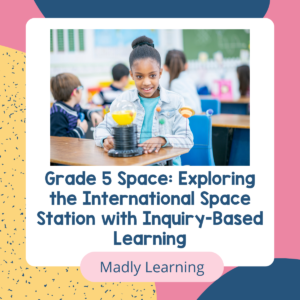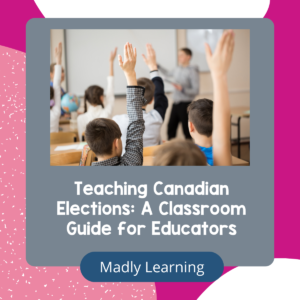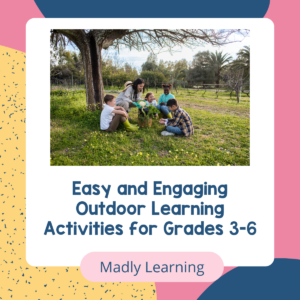Autonomy: the power to be independent and free; freedom from external control or influence.

Increasing student autonomy in my classroom has led to
- Classroom management is easier
- The time I take to plan a lesson, or unit etc has decreased
- I develop stronger relationship with my students
- Teaching is easier
- Students learn and retain more
I know bold right…but it is true!!
People ask me all the time how I do it. I teach full time, have three little kiddos at home, a husband I like spending time with, a TPT store, FB live…. etc.
Do I sleep? Yes when the baby lets me…lol
But as a teacher, I have time in my life for these things because I use inquiry and give my students more autonomy. It’s not working harder it is working smarter.
Voice and Choice
Students don’t want to come to school and be told what to do every minute of every day. They want to have a purpose and a choice in what they do.
Increasing voice and choice is the single most effective thing that reduces the time it takes to plan a lesson.
If they are doing it I don’t have too
I have my curriculum expectations, I know what needs to be covered. I share this with them. Then together in class, we brainstorm ways to do this to accomplish these goals. I give some suggestions, I listen to their ideas, we refine our list then they do it.
What am I not doing? Planning 6 different differentiated assignments at home that I think they will enjoy.
I simply just ask them what they will enjoy. We design it together, in class, then they do it.
Coach and Guide
Imagine your classroom as a basketball court. As the teacher where are you?
What is the role of the coach?
The coach gives the students time to practice, shows them different drills, teaches them the rules, all so that when it is game-time the students know how to play.
As a teacher, this is my role too
- I guide students but I don’t do it with them or for them. I try to avoid being a helicopter teacher. Learning isn’t always easy and there are pitfalls and consequences. Learning from mistakes is key to self-directed and self-motivated learners.
- I don’t do all of the ‘heavy lifting’ in learning. They get to help too. Sometimes it is a matter of me just getting out of their way since I can over complicate things or make assumptions.
- I leverage student questions and interest to guide what we do.
- I give them meaningful choices and provide feedback.
- I link what we do and why we do it. Giving a purpose to what we are learning.
Classroom Management
Choice, freedom and control are not finite. By the teacher giving up some control over the direction of learning does not mean that you cease to be the leader in your classroom.
Even a democracy needs a leader.
In fact, I think of my classroom as a sort of constitutional monarchy. I am the head of the classroom but I simply just provide the framework and oversight to make sure things run smoothly. I provide the rules but they decide how they will work within this system. They have choices and ownership in what happens. They have rights and responsibility.
When corrections happen or we lose our way I step in but they see why. I hold them accountable for their choices.
As a teacher that gives autonomy in their classroom, I am still involved. I am not giving anything away by asking them to share their ideas and opinions on how the classroom should be run. My classroom belongs to my students just as much as it belongs to me (even though I will never let them decorate it)
- Together we make goals about what we want to work on
- We talk about ourselves as a team that needs to work together and support each other in order to be successful.
- We understand that everyone brings different skills and value to the group so we don’t expect that same thing from the same people but we all play our part.
- Everyone has a role and a purpose to help us be successful.
You can read more about my classroom management here
Social and Emotional
Our students deal with a lot
So when we increase the autonomy we also have to increase the support to prepare them for this.
This is why a classroom still needs to be predictable, structured and organized. (they just get a say in what this looks like)
But the center of the classroom is not the teacher but it is the student learning. We are all there to learn. Together we work together to ensure learning, real learning, deep learning happens.
But this also means that we need to deal with the social and emotional issues that get in the way of learning.
- bullying
- self esteem
- mental health
- nutritional
- physical
All of these have an impact on how our students learn.
As a teacher in an autonomous classroom, I am there to support, lead, build confidence, focus on goals and strengths, see the student as an individual, make a plan to compensate for deficits and needs.
I am even there to teach. I still do a fair amount of teaching.
I teach by modelling different strategies, facilitation discussions, help them make connections between old and new information.
Overall giving my students more autonomy works!
- They have choice
- They have a say
- They feel heard
- They take ownership and responsibility
- They develop as individuals with a unique set of strengths and goals
To read more about this topic including the research sources used in this blog post
Barbara McCombs: Developing Responsible and Autonomous Learners: A Key to Motivating Students
6 Strategies for Promoting Student Autonomy
Strategies for Helping Students Motivate Themselves






